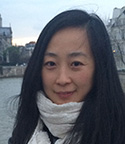Recently, we’ve been profiling first authors of Plant Cell papers that are selected for In Brief summaries. Here are the first-author profiles from the June issue of The Plant Cell.
Yuki Kondo, featured first author of Vascular Cell Induction Culture System Using Arabidopsis Leaves (VISUAL) Reveals the Sequential Differentiation of Sieve Element-like Cells
Current Position: Assistant Professor at The University of Tokyo.

Education: PhD: Department of Biological Sciences, Graduate School of Science, The University of Tokyo.
Non-scientific Interests: Fishing, cooking.
I began my research on peptide hormone signaling pathways at The University of Tokyo. At that time, my studies focused on vascular xylem development. Based on this knowledge, I recently succeeded in establishing a tissue culture system for ectopic xylem differentiation using Arabidopsis leaves. Unexpectedly, I found that this culture system (named VISUAL) can induce not only xylem tracheary elements but also phloem sieve elements. Many unsolved mysteries about phloem differentiation still remain. Also, vascular stem cells can give rise to both xylem and phloem cells via unidentified mechanisms. Thus, my research interests are gradually shifting to phloem and multi-potent vascular stem cell differentiation. I believe that VISUAL will help me answer many interesting questions about these processes.
Sofía Otero and Bénédicte Desvoyes, featured co-first authors of Histone H3 Dynamics Reveal Domains with Distinct Proliferation Potential in the Arabidopsis Root
Sofía Otero
Current Position: Postdoctoral Research Associate at The Sainsbury Laboratory (University of Cambridge), in the group of Yka Helariutta.
Education: PhD in Molecular Biology (Universidad Autónoma de Madrid).
Non-scientific Interests: Writing, reading, tweeting (@gene_tonic_), hiking, travelling, watching the latest tv series, fitness, animals (2 or 4 legs), the Mediterranean Sea, and chocolate.
Small details make a big difference. This is exactly the case with histone H3 family, where changing only 4 amino acids completely modify the dynamics and properties of the canonical H3, generating a more versatile variant. Not a lot was known about H3 variants in plants when I joined Crisanto’s lab in 2010. The almost untouched field together with the amazing characteristics of histones soon captivated me. Indeed, histones are extraordinary proteins: they are in the nucleus, influencing DNA, and like the genetic material, are inherited. Trying to understand histone dynamics in the root we ended up understanding the root better: we not only finely classified meristematic domains, but also learned that cells cycle at different speeds along the root meristem. Again we show that chromatin seems to have a key role in developmental transitions. Although this research was carried out in Spain, where I was born some time ago, I currently live in Cambridge (United Kingdom). I am curious, enthusiastic and can sing in karaokes.
Bénédicte Desvoyes
Current Position: Postdoctoral Research Associate at Centro de Biología Molecular Severo Ochoa, Madrid, Spain.
Education: PhD in Life Science, University of Franche Comté, Besançon, France.
Non-scientific Interests: Reading, watching movies, hiking, wine tasting and experimental cooking.
After my Ph.D at the University of Franche Comté in plant biochemistry, I did a first postdoc in the plant virology field to study host/virus interaction at Texas A&M University, USA. Studying the plant side of the viral infection, I became more and more interested in plant development and when I came back to Europe I decided to move on to this field. I had the opportunity to join Crisanto Gutierrez’s lab in Madrid, Spain. There, I became very interested in understanding how the cell cycle could influence plant development studying first the role of some specific transcription factors (Retinoblastoma/E2F pathway) in gene regulation networks and now, moving on to epigenetics, how chromatin dynamics can influence the proliferation/differentiation rate. In this project, we determined that histone H3 variants balance (H3.1 and H3.3) define different domains along the root coinciding with different cell cycle length.
Wenjia Xu, featured first author of Endosperm and Nucellus Develop Antagonistically in Arabidopsis Seeds
Current Position: Postdoctoral researcher, Shanghai center for Plant Stress Biology, Shanghai Institutes for Biological Sciences (SIBS), Chinese Academy of Sciences (CAS).
Education: PhD (2014) in Plant Molecular Biology at Institut Jean-Pierre Bourgin (IJPB), Institut National de la Recherche Agronomique (INRA, Versailles), and also at the University of Paris-Sud in France; MS (2010) in Cell Biology at the Northeast Forestry University in China.
Non-scientific Interests: Mountain hiking, climbing, shopping and karaoke with friends.
My first introduction to science was my father explaining rules of plant growth on a farm in my childhood. I still remember looking forward to sprouting time in spring and harvesting fruits in autumn as a child. I started to love science and later chose plant science for a major in my university studies, with the goal of understanding mechanisms at work inside plants. After finishing my B.Sc., I pursued my master’s degree in the lab of Dr. Xiufeng Yan at the Northeast Forestry University in China to investigate the interaction between plants and the environment. I realized that we need to understand plants at the molecular level to explain ecological problems, and therefore wanted to have further study abroad. Fortunately, I got an offer to earn my Ph.D. with Dr. Loïc Lepiniec and was co-supervised by Dr. Christian Dubos in my studies of transcriptional regulation of flavonoid biosynthesis. During my Ph.D., we worked on the transcriptional regulatory pathway leading to proanthocyanidin and anthocyanin biosynthesis in Arabidopsis. In the meantime, I have obtained a solid foundation for science research through a 4-year theoretical and practical training. I am very lucky for the great opportunity to continue research in the same group as a postdoc under the supervision of Dr. Enrico Magnani. We are investigating the development of the gametophyte and surrounding maternal tissue, and this work sheds new light on the molecular mechanisms underlying seed tissue partitioning and architecture, as described in this paper. The work we did really fascinated me, and it gave me the enthusiasm and confidence to move on in science. I am deeply grateful to all my supervisors, who give me these opportunities to pursue science and also have faith in my maturation as a scientist with great patience and support.
Shuangshuang Zhao, featured first author of Casein Kinase1-Like Protein2 Regulates Actin Filament Stability and Stomatal Closure via Phosphorylation of Actin Depolymerizing Factor
Current Position: Graduate student, Key Laboratory of Plant Stress, Life Science College, Shandong Normal University, at Jinan, China.
Education: M.S (2012) in Development Biology at Shandong Normal University, at Jinan, China and B.S (2006) in Life Science at Liaocheng University, Liaocheng, China.
Non-scientific Interests: Reading elegant prose, listening soft music, cooking, travel, being a wife and homemaker, playing with my daughter.
I was born in a small village next to a branch river of Yellow River, in Shandong, China. As a child of a peasant family, I spent most of my time after school on the farm and had ample opportunity to learn about crops. I was fascinated by the mechanisms that plants use to make their way under adverse growth conditions. Thus I decided to study biology at University. After I graduated I was fortunate to be given the opportunity to be employed as a technician in Dr. Yan Guo’s lab at the National Institute of Biology Sciences (NIBS), Beijing. Dr. Yan Guo has been working on plant response mechanisms to environmental stresses such as salt stress, drought stress, and alkaline stress etc. During my time in NIBS from 2006 to 2010, I started the study on the mechanisms of plant response to drought stress through regulation and remodeling of the actin cytoskeleton. In my Ph.D studies in Dr. Yan Guo’s lab in China Agricultural University from 2010 to now, I have focused on a drought sensitive mutant screen. I identified a kinase CKL2 associated with actin and involved in stomatal closure regulation through phosphorylation on actin depolymerizing factor ADF. It is still very fascinating for me how dramatically CKL2 kinase activity to ADF is regulated by CKL2 interaction partner in different environmental conditions. Through protein-protein interaction screening, we identified the regulatory protein interacting with CKL2 on actin filaments. I would like to continue exploring the regulatory network involving CKL2 and actin dynamics. I hope this work will provide a valuable resource for other labs researching actin cytoskeleton function in stomatal closure.
Wenna Zhang, featured first author of tRNA-related sequences trigger systemic mRNA transport in plants
Current Position: Postdoctoral researcher, Department of Vegetable Science, College of Horticulture, China Agricultural University.
Education: PhD (2011): Department of Fruit Tree Science, College of Agronomy and biotechnology, China Agricultural University.
Non-scientific Interests: Reading, Painting, Photography and visiting museums.
When I finished my M.Sc , my supervisor introduced his projects and suggested that I choose one research field to be my Ph.D subject. I chose the topic “RNA long distance transport in grafted plants” without hesitation because it was really interesting and attractive, from then I started to walk into the world of mobile RNA signals. After my Ph.D study, there were still some questions in my mind, such as why and how RNAs move in plants. Then I fortunately got an opportunity at the Max-Planck Institute of Molecular Plant Physiology (MPIMP) as a Post-Doc. After more than four years postdoctoral research, under Dr. Friedrich Kragler’s cautious guidance, I have gained more experimental techniques and a deep understanding of systemic RNA movement in plants. I also learned how to be a good scientist from him. We succeeded in investigating siRNA signals transmission into flowers (Zhang & Kollwig et al., 2014), identifying a high number of endogenous mRNAs that move in plants (Thieme et al., 2015). Beyond that, recent research results on potential role of TSL (tRNA-like structure) motifs in mRNA transport proposed a novel comprehensive mechanism for why mRNAs move in plants. This work gave me the confidence to move on in plant science; moreover, I am deeply grateful for the help and support from my group leader, Dr. Friedrich Kragler and all my excellent colleagues in MPIMP.
